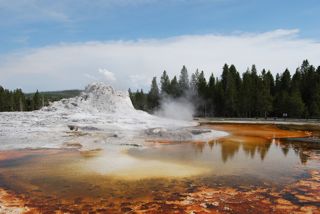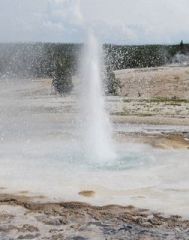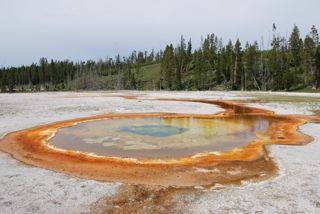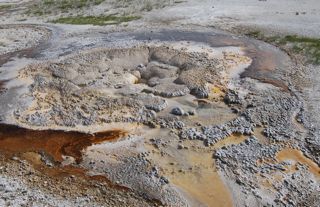 This evening I explored the Upper Geyser Basin and wandered among the colorful cyanobacteria—the creatures responsible for the vibrant hues in the thermal features.
This evening I explored the Upper Geyser Basin and wandered among the colorful cyanobacteria—the creatures responsible for the vibrant hues in the thermal features.
While witnessing all of this volcanic activity, it occurred to me how strong our notion is of the ground beneath our feet being solid and secure. A trip to Yellowstone quickly debunks that view---the earth’s restlessness never ceases below us, but in Yellowstone we’re allowed to peer beneath the surface to an underworld of fire.
 Castle Geyser: The mineral cone formed over thousands of years. Castle has a reputation for being unpredictable, as T. Scott Bryan observes in his book The Geysers of Yellowstone, “When we talk about the personalities of geysers, Castle heads the list. It has been known to undergo at least four different types of eruptions.”
Castle Geyser: The mineral cone formed over thousands of years. Castle has a reputation for being unpredictable, as T. Scott Bryan observes in his book The Geysers of Yellowstone, “When we talk about the personalities of geysers, Castle heads the list. It has been known to undergo at least four different types of eruptions.”
Sawmill Geyser: A fountain-type geyser with eruptions that can produce a burst of water up to 35 feet in height.
 Chromatic Pool: A lesson in thermal features—geysers are characterized by a broken, underground plumbing system. The water’s path becomes constricted, heat cannot escape, and the pressure increases until critical mass is reached.
Chromatic Pool: A lesson in thermal features—geysers are characterized by a broken, underground plumbing system. The water’s path becomes constricted, heat cannot escape, and the pressure increases until critical mass is reached.
Hot springs resemble geysers in principle, but lack the broken plumbing; water flows freely to the surface to release heat. Chromatic may lack the showy plume of a geyser, but the striking color more than compensates.
 Anemone Geyser: Growing up near the ocean, I loved seeing Yellowstone’s version of one of my favorite sea-creatures. The color and texture of its sinter (the deposits surrounding the geyser) truly does resemble a true anemone’s pink and orange bulbous tentacles.
Anemone Geyser: Growing up near the ocean, I loved seeing Yellowstone’s version of one of my favorite sea-creatures. The color and texture of its sinter (the deposits surrounding the geyser) truly does resemble a true anemone’s pink and orange bulbous tentacles.
